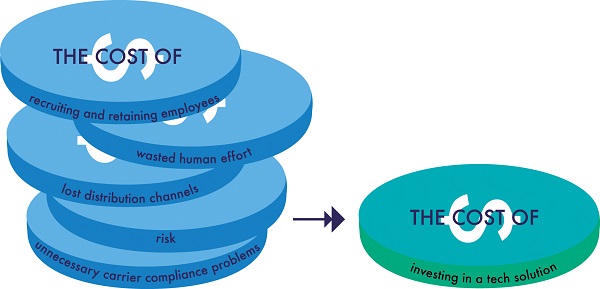4 Ways the Cost of Doing ‘Business As Usual’ Could Be Hurting Your Agency

By: Ellen Lichtenstein & Regina Stephenson
People often think change is expensive. But what about the cost of staying the same? When your business doesn’t invest in process improvements, including modern technology and automation, you run the risk of paying the price in the long run.
We love a good analogy, so let’s think for a minute about your car. Let’s imagine you own a car that’s 20+ years old and has 300,000 miles. Suspend your disbelief for a moment, or at least pretend it’s a Toyota.
You’ve long since paid it off, so there’s no monthly car payment. And your auto insurance is dirt cheap because you don’t even bother with comprehensive coverage. Wind, hail and fallen trees be damned!
Your cost of ownership may feel like it’s small compared to the idea of buying a new car, but the reality is that not making a change is costing you more than you’d like to admit. While you’re focused on the large down payment or the higher-than-zero monthly installment, you forget about things like:
- New high-tech safety features that can prevent accidents before they happen.
- Fuel efficiencies that save big money on gas—or eliminate gas altogether.
- Zero-cost maintenance for your first few years.
- Lower insurance premiums for cars with anti-theft devices and internet-enabled tracking.
- Warranty coverage for major mechanical failures within the first five or even 10 years of ownership.
When you really think about it, it’s often costing you more to stick with something you’ve had forever than to embrace something new.
This same thing happens in businesses all the time. When people think about upgrading their internal processes—replacing manual work with technology, for example—all sorts of obstacles get in the way.
Here are a few excuses:
- “It’ll be too expensive.”
- “It’ll take too much time or effort.”
- “We’ll sacrifice productivity while people get up to speed.”
- And our personal favorite, “But we’ve always done it this way!”
Just like that old car, the costs at the forefront of our minds are usually temporary, and much less over time, than the ones we’ll pay to keep doing things the old way. It’s tempting to think the only cost you face is the one for adopting a new technology solution, but what seems like a good and cost-effective method now is actually costing you more than you realize.
For example:
- Duplicate work because of data and workflow silos.
- Lost revenue due to producer downtime between hiring and being ready to sell.
- Bloated recruiting costs due to a cumbersome employee experience that results in high turnover.
- Human error due to manual and repetitive tasks that could easily be automated for greater speed and accuracy.
The Price of Doing Nothing
When an organization considers adding new people, processes, or technology—or all of the above—the first knee-jerk questions are usually, “How difficult will this change be?” and “How much is this going to cost us?” But what if most organizations are looking at it all wrong?
Instead of asking how much it’ll cost to make a change or improvement, maybe we should be asking ourselves how much it will cost to stay the same: To do things the way we’ve always done them.
Money talks. And failure to evolve can definitely hurt your bottom line in a variety of ways. But not all costs are created equal. The ones that weigh more heavily in your decision-making will vary from one organization to another.
Here are some of the most common factors to consider when you’re evaluating what it really costs to do things the way you’ve always done them:
 1) Wasted Human Effort
1) Wasted Human Effort
How many humans does your organization need to manage your producer licensing and compliance, just as one example? For each of those administrative employees, you’ve got to pay for a salary, benefits, taxes, potentially office space, equipment and many other hard costs.
More producers and customer service representatives (CSRs) require fewer administrative or operational heads. We promise you there are better jobs for humans than manually and tediously going through the motions of producer compliance management.
2) Recruiting and Training
Employees these days have more choice over where and how they work than ever before. If your organization isn’t putting systems in place that make your employees’ jobs easier, less tedious and more efficient, then you’re going to lose out on the best talent to companies that are.
The average cost of a new hire is nearly $4,700, according to new benchmarking data from the Society for Human Resource Management (SHRM), but once “soft costs” like time invested by leadership throughout the hiring process are factored in, the real price may be as high as three to four times the position’s salary.
When your company doesn’t implement modern technology to make your employee experience truly exceptional, you risk losing everyone, from the producers you rely on to sell, to the compliance managers who oversee producer licensing, to the CSRs who service your clients’ policies.
Also, no one likes repetitive tasks with a high probability for errors. But if everyone in your organization is subject to old-fashioned processes that reinforce information silos, multiple and conflicting sources of information and mind-numbing repetition, the odds of attracting and retaining the best talent are slim.
Drastically improving your employee experience by upgrading your tech is also something you really don’t want to put off for another day, as the competition for insurance talent is one of the industry’s top and ever-growing concerns.
3) Agency Risk
Managing producer licensing and compliance on paper with spreadsheets or by any other manual and human-based method is full of risks.
The more complex your compliance picture, the more risk is involved. What seems reasonable for an insurance agency with 50 producers working in one or two states and with only a few carriers becomes a minefield of risks when it grows to 200 producers working across all 50 states with 15 insurance companies.
When you consider the risks of doing things the way you’ve always done them, consider each of these elements:
- Compliance risks. What are the chances that one of your producers has a license that’s expired in one of the states they’re currently selling in? Do you know with 100% certainty that every producer in your distribution channel is properly licensed in every state and appointed with every carrier both when they sell and when commissions are paid?
- Security risk. How secure is your clients’ information? Are you storing personal identifiable information? What types of information security protocols are in place? Have you invested in best-in-class information security measures and training for all staff? What are the chances someone has access to information they shouldn’t? Or that “secure” information is being kept in unencrypted documents or even on someone’s desk?
- Reputation risk. What would it cost to repair your reputation if your organization made headlines because of a compliance misstep or security breach? Have you considered the financial ramifications of not only immediate legal defense, but public relations work and lost business from customers or investors who decide to leave after a public incident?
4) Distribution Channels
Without carrier partners, you’ve got no products to offer your clients. And if your internal processes make it hard for carriers to get their insurance business in front of consumers, or present risks the carriers aren’t willing to take, then you’re going to be hard-pressed to sell policies.
Most states allow carriers to take advantage of just-in-time (JIT) appointments, which is the ability for a carrier to postpone paying the appointment fee for a producer until the producer has made their first sale.
This sounds great in theory, but the timing has to be just right. You can’t wait weeks or months after the producer writes their first policy to trigger the appointment. So, many carriers refrain from taking advantage of JIT appointments altogether because they don’t want to end up with noncompliance issues.
Would you believe modern technology has a solution that gives carriers the money-saving benefit of JIT appointments and agencies the peace of mind that the appointments will happen when they need to for compliance?
Nothing in life is free, but you get to choose the costs you’re willing to pay and those you’re not. Are you sure you’re willing to pay the price of staying the same?
Ellen Lichtenstein is senior content specialist at AgentSync. Regina Stephenson is a writer and editor at AgentSync. This article is based on AgentSync’s guide to the price of business as usual in the insurance industry, “What’s the Cost of Doing Nothing?“










